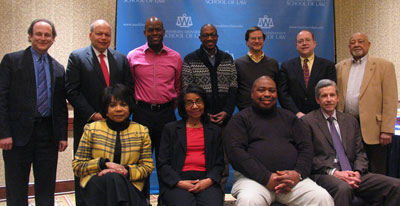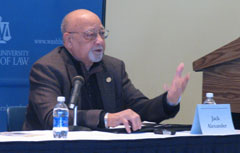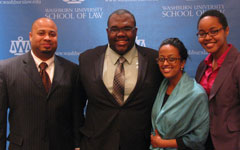Brown v. Board at 60 Symposium
The 60th anniversary of the United States Supreme Court’s landmark decision that “separate educational facilities are inherently unequal” was commemorated at the Brown v. Board at 60: Looking Back – Looking Forward Symposium. Washburn Law’s Center for Law and Government and the Washburn Law Journal co-hosted the symposium on February 27 at the Bradbury Thompson Alumni Center.

Front row: Cheryl Brown Henderson, Shirley A. Hill, Abel A. Bartley, and
William Yeomans. Back row: Juan F. Perea, Ted Shaw, Preston Green III,
Cedric Merlin Powell, Chris Hansen, Joseph Zima, and Jack Alexander.
Distinguished experts from across the United States participated in three distinct plenary sessions at the symposium. The first panel, “The Life of Brown,” examined the history of the Brown v. Board litigation and the effort to desegregate Kansas public schools in the aftermath of the decision and focused on the 1979 re-opening of the case.
During lunch, Jack Alexander spoke about his experiences as an African-American student in the Topeka school district during the 1950s.
The second panel, “Race and Education Today,” addressed the current state of the U.S. educational system in light of the social, economic, and legal developments since Brown. Special focus was placed on school funding issues; social and cultural factors that contribute to de facto school resegregation; and the Supreme Court’s change in direction on desegregation issues, as seen in Missouri v. Jenkins, Parents Involved, and other cases.
Contemporary Race Issues: Confronting Inequality in the 21st Century was explored during the third panel. This included recent decisions by the Supreme Court — on marriage, voting rights, employment discrimination, and affirmative action, among others — in an attempt to determine how the Roberts Court has embraced or rejected Justice Marshall’s vision, and whether the current Court’s approach to civil rights issues is an improvement or a regression on the Warren Court’s approach in Brown.

